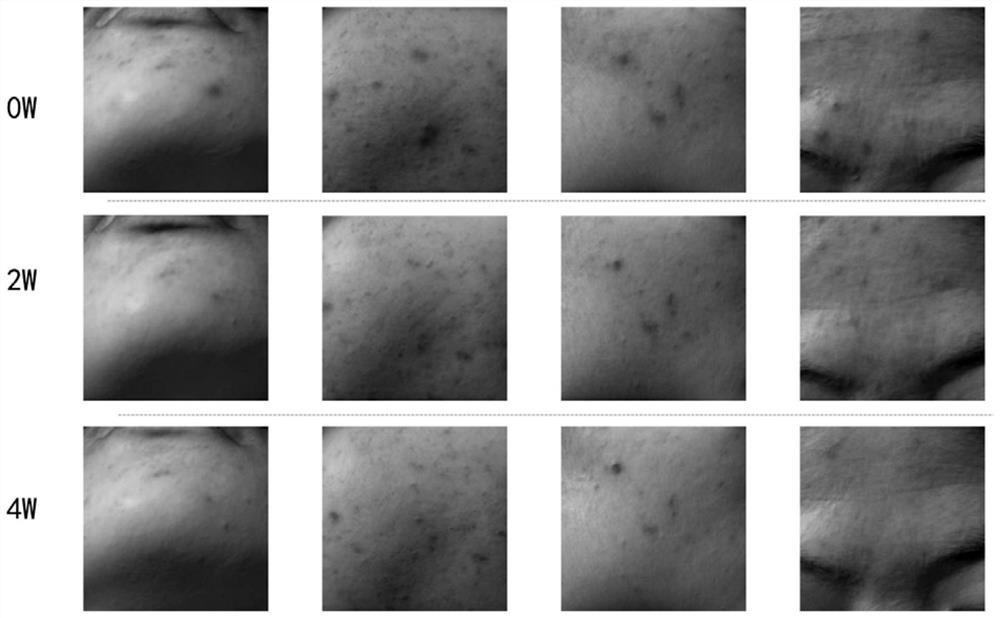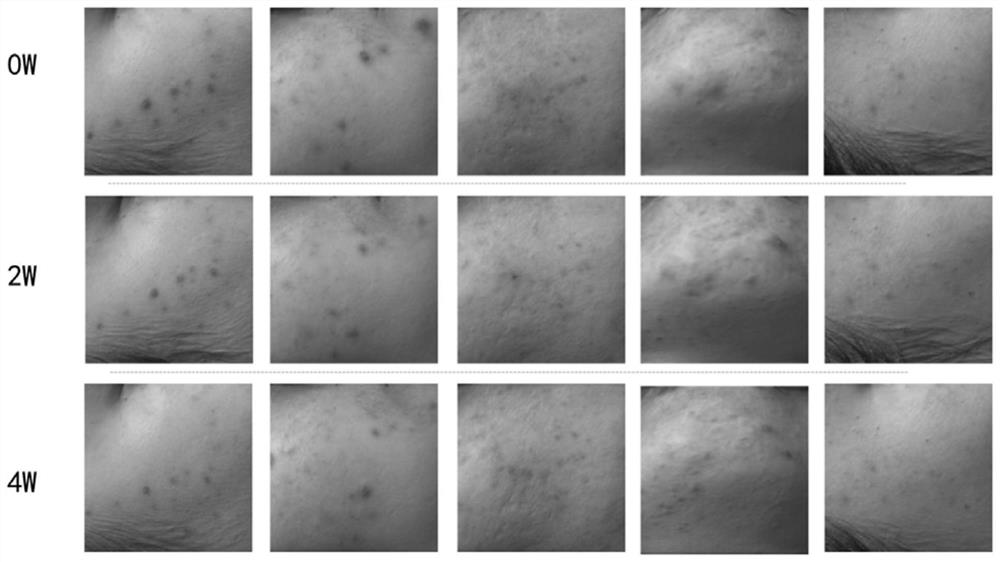Anti-acne and anti-inflammatory composition and preparation method and application thereof
An anti-inflammatory composition and a technology of the composition, applied in the field of daily chemicals, can solve the problems of unsafe and improper, skin barrier damage, blackheads and enlarged pores, etc.
- Summary
- Abstract
- Description
- Claims
- Application Information
AI Technical Summary
Problems solved by technology
Method used
Image
Examples
Embodiment
[0029] In the following examples and comparative examples of the present invention, the antipruritic and soothing composition is prepared by the following process.
[0030] (1) Pulverize the plant raw materials respectively, dry them, pass through a 60-mesh sieve, weigh them according to the proportioning ratio, and mix them evenly;
[0031] (2) adding ethanol for extraction, the mass ratio of the crude drug to ethanol (35%) is 1:20, the extraction temperature is 50°C, the microwave is 7min, the ultrasonic time is 40min, and the extraction times is 2 times;
[0032] (3) cooling the extract obtained in step (2) to 25° C., filtering with 200 mesh gauze to obtain the initial filtrate;
[0033] (4) centrifuging the primary filtrate obtained in step (3) for 30min, the rotating speed is 6000rpm with a microfiltration membrane with a pore size of 0.5 μm to filter, collect the filtrate, and obtain the secondary filtrate;
[0034] (5) Concentrate the secondary filtrate obtained in ste...
experiment example 1
[0045] Antibacterial test
[0046] Bacteriostatic effect detection
[0047] Selection of strains: Staphylococcus aureus, Escherichia coli, Pseudomonas aeruginosa, Propionibacterium acnes; Pseudomonas aeruginosa \ Staphylococcus aureus \ Escherichia coli \ Propionibacterium acnes were selected for the preparation of bacterial solution for the listed species. Preparation: Dilute it with sterile physiological saline to a bacterial suspension of about 1.0x105cfu / ml~1.0x106cfu / ml. The prepared bacterial suspension should be used within 2 hours, or stored at 2°C to 8°C for no more than 24h.
[0048]Bacteriostatic effect test: Take the functional plant composition obtained in step (5) of the example, take a piece of sterile dry filter paper, and add 20 μL of the plant composition solution (10 mg / mL) of the actual concentration to each piece dropwise. Test bacteria inoculation: Take 1mL of each test bacteria suspension and spread evenly on the surface of the nutrient agar medium; p...
experiment example 2
[0055] Experimental example 2. In vitro antioxidant test
[0056] 1. DPPH free radical scavenging test
[0057] Precisely pipette 2.0mL of 50% ethanol DPPH solution (0.2mmol / L), add 2.0mL of the test solution, mix well and shake well, after 30min, measure the absorbance A at 517nm, measure 3 times in parallel, and take the average value , with vitamin C as a positive control. Calculate the scavenging rate of each test solution to DPPH free radicals by the following formula:
[0058] DPPH clearance rate (%) = [1-(A i -A j ) / A 0 ]*100%
[0059] In the formula: Ai is the absorbance of the reaction after adding the test substance;
[0060] Aj is the absorbance of the test solution itself;
[0061] A0 is the blank value without adding test solution.
[0062] 2. OH radical scavenging test
[0063] Hydroxyl radicals were generated using the Fenton reaction. Add 1.0mL of FeSO4 solution (9.0mmol / L), 1.0mL of salicylic acid ethanol solution (9.0mmol / L) and 1.0mL of test solu...
PUM
 Login to View More
Login to View More Abstract
Description
Claims
Application Information
 Login to View More
Login to View More - R&D
- Intellectual Property
- Life Sciences
- Materials
- Tech Scout
- Unparalleled Data Quality
- Higher Quality Content
- 60% Fewer Hallucinations
Browse by: Latest US Patents, China's latest patents, Technical Efficacy Thesaurus, Application Domain, Technology Topic, Popular Technical Reports.
© 2025 PatSnap. All rights reserved.Legal|Privacy policy|Modern Slavery Act Transparency Statement|Sitemap|About US| Contact US: help@patsnap.com



